Renal Physiology
1/52
There's no tags or description
Looks like no tags are added yet.
Name | Mastery | Learn | Test | Matching | Spaced |
|---|
No study sessions yet.
53 Terms
Kidney Regulation
Blood volume (plasma volume) and pressure.
Water concentration and fluid volume.
Inorganic ion composition.
These two factors keep pressure under homeostatic conditions.
Kidneys Balance
They help regulate the acid-base balance.
Kidneys Excretion
Urea, uric acid, creatinine, and bilirubin (breakdown product of Hb).
Removal of foreign chemicals (i.e. drugs, food addictives, pesticides.
Uric Acid
Produced from the breakdown of nitrogenous bases.
Creatinine
Byproduct of muscle metabolism.
Kidneys Synthesis
Glucose (gluconeogenesis).
Kidneys Secretion
Acts as a endocrine organ, secreting cytokines or hormones.
Erythropoietin (EPO) → synthesized in the kidney.
Renin.
1,25-dihydroxy Vitamin D (inactive form).
Fluid Compartments
Total body water: 42L, around 60% body weight.
Plasma is 3L, the interstitial fluid is 11L, and the intercellular fluid 28L.
Functions of the kidneys is to maintain the plasma volume within a narrow range.

Fluid Volume Changes
During various health disorders.
By rapid movement water (osmosis).

Intracellular Fluid (ICF)
The fluid inside the cell.
Extracellular Fluid (ECF)
Fluid outside the cell.
Plasma + interstitial fluid + cerebrospinal fluid.
Plasma
Non-cellular part of blood, fluid inside blood vessels.
Kidney Regulates ECF
The ECF is made up of:
Plasma.
Interstitial fluid.
Cerebrospinal fluid.
Dominant Ions in ECF
Na⁺, HCO₃⁻, Cl⁻.
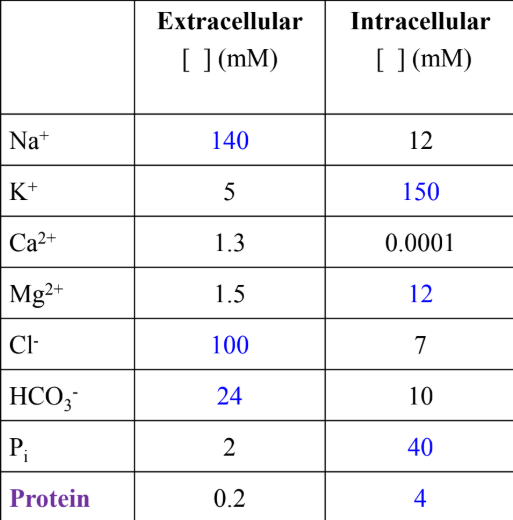
ICF Dominant in ICF
K⁺.
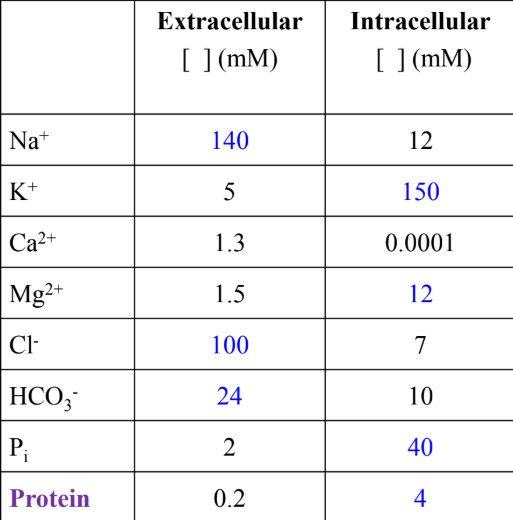
Diffusion
Rate of water diffusion that will affect fluid volume.
A low and finite degree of H₂O can diffuse through the tissues.
Aquaporins: water channels.
Osmoles
1 osmoles (osm) is equal to 1 mole of solute particles.
Osmolarity
Number of solutes per unit volume of solution expressed in moles per liter.
The addition of solute lowers the water concentration.
Addition of more solute would increase the solute concentration and further reduce the water concentration.
Diffusion
Is the movement of molecules from one location to another due to their random thermal motion.
Molecules initially move from a region of higher concentration to lower concentration.
Over time, solute molecules placed in a solvent evenly distribute themselves.
Diffusional Equilibrium
Is the result of diffusion.
Happens over time as solute molecules placed in a solvent evenly distribute themselves.
Osmosis
Net diffusion of water across a selectively permeable membrane from a region of high water concentration → lower water concentration.
Osmotic Pressure
The pressure necessary to prevent solvent movement (osmosis).
Reaching Diffusional Equilibrium
The partition between the compartments is permeable to water and solute.
After diffusional equilibrium has occurred, movement of water and solutes has equalized their concentrations on both sides.
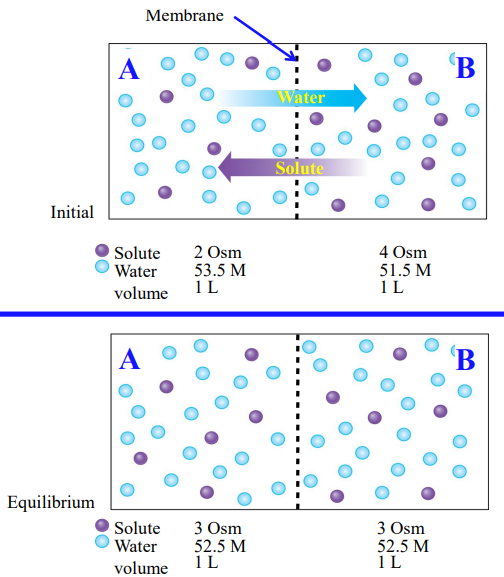
Reaching Osmosis
The partition between the compartments is permeable to water only.
After diffusional equilibrium has occurred, movement of water has equalized solute concentration.
The opposing pressure required to stop osmosis completely is equal to osmotic pressure.
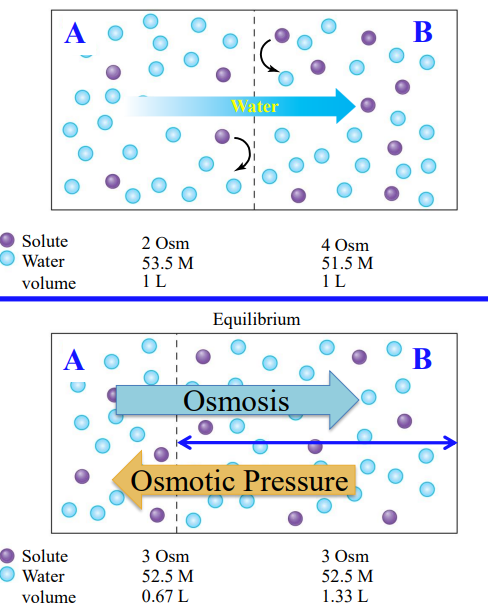
Tonicity
Is determined by the concentration of non-penetrating solutes of an extracellular solution relative to the intracellular environment of a cell.
The solute concentrations may influence changes in cell volume.
Isotonic (Isoosmotic)
Same osmolarity outside and inside the cell.
Hypertonic (Hyperosmotic)
Higher osmolarity than inside of the cell.
Hypotonic (Hypoosmotic)
Lower osmolarity than inside of the cell.
Osmolarity Gradient
Water flows from osmolarity to higher osmolarity.
Normal osmolarity inside a cell is about 300mOsm/L.
Non-Penetrating Solutes
Solutes that cannot easily cross the cell membrane and establish osmotic gradients, thereby influencing cell volume and tonicity.
They are crucial for maintaining fluid balance.
i.e. Na⁺ and K⁺.
Penetrating Solutes
Solutes that can freely cross cell membranes, meaning they do not establish a sustained osmotic gradient.
Do not directly influence cell volume or tonicity.
i.e. urea.
Changes in Cell Volume
In a hypertonic solution the cell shrinks.
In a isotonic solution the cell volume does not change.
In a hypotonic solution the cell swells.
Absorption
Movement of solute/water into the blood (plasma).
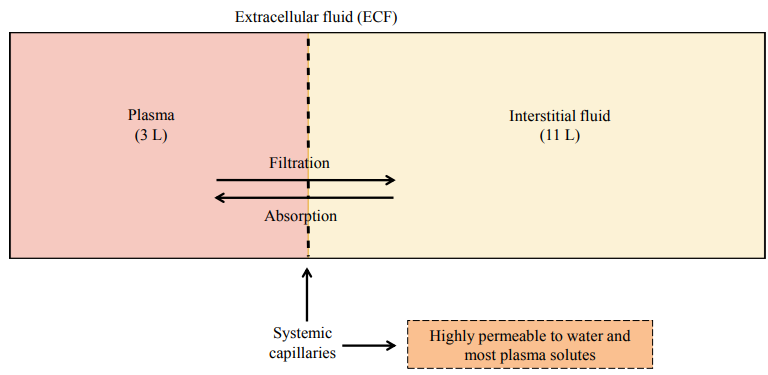
Filtration
Movement of solute/water out of blood (plasma).

Plasma Proteins + Movement
Plasma proteins in the blood create osmotic pressure.
This draws water into the capillary from the interstitial space.
Some plasma proteins may escape into the interstitial fluid.
Proteins
Big molecules that are sometimes charged.
Due to their size and charge, they cannot move in & out of capillaries easily.
Unable to cross capillary walls.
Capillary Hydrostatic Pressure (PC)
Pressure exerted on inside of capillary walls by blood.
Favors fluid movement out of capillary.
Interstitial Fluid Hydrostatic Pressure (PIF)
Fluid pressure exerted on the outside of the capillary wall by interstitial fluid.
Favors fluid movement into capillary; pressure is negligible & does not contribute.
Blood Colloid Osmotic Pressure (πC)
Osmotic pressure due to nonpermeating plasma proteins inside the capillaries.
Favors fluid movement into the capillaries.
Interstitial Fluid Colloid Osmotic Pressure (πIF)
Small amount of plasma proteins may leak out of capillaries into interstitial space.
Favors fluid movement out of capillaries; negligible.
Starling Forces
Net filtration pressure = PC + πIF - PIF - πC.
Govern the movement of fluid across capillary walls, determining whether fluid moves out of the capillary (filtration) or back into it (reabsorption).
Fluid Movement in Capillaries
At the arterial end, starling forces favour filtration. at the venous end, they favour reabsorption.
Filtration dominates at the arterial end; reabsorption at the venous end.
Overall, slightly more fluid is filtered than reabsorbed, with the excess drained by the lymphatic system.
Homeostasis
Total body balance of any substance; keeping levels constant and maintained.
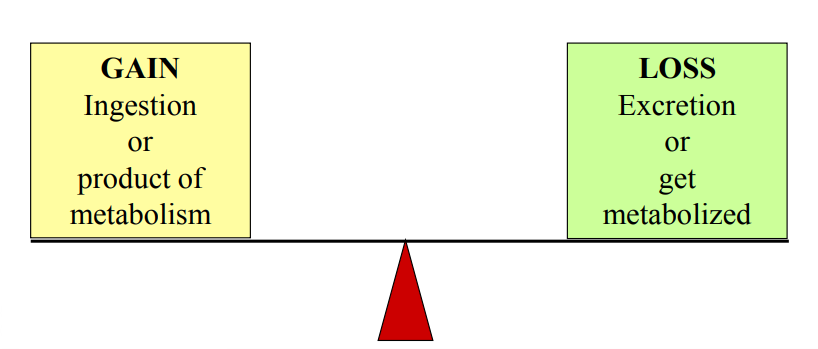
Urinary System
The kidneys are retroperitoneal (behind the peritoneum) in location.
Other structures associated with the urinary system include the ureters, bladder, and urethra.

Ureters
Drain the formed urine from the kidneys.
Travel to the bottom of the abdominal cavity and empties into the bladder.
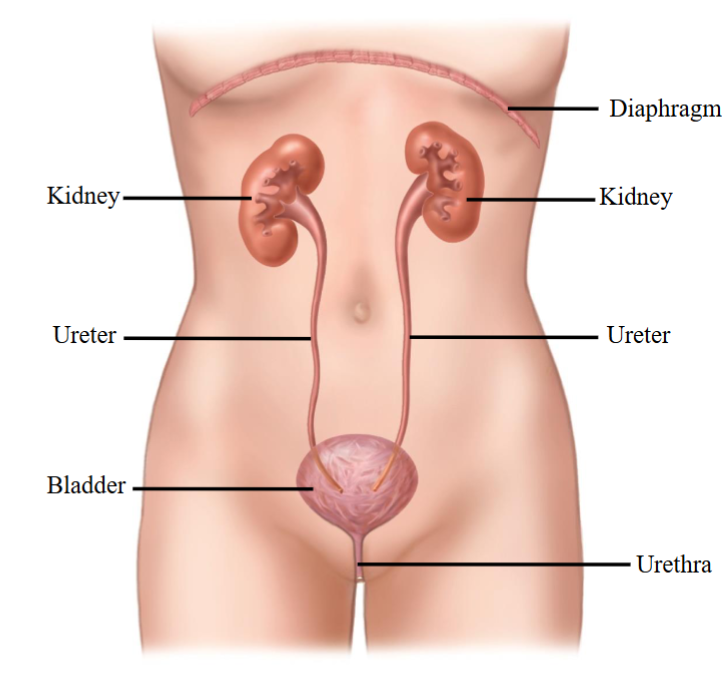
Bladder
Storage organ or sac.
Innervated by the ANS.
Voiding of the bladder is controlled by SNS/PSNS.
Bladder empties out of the body through the urethra.
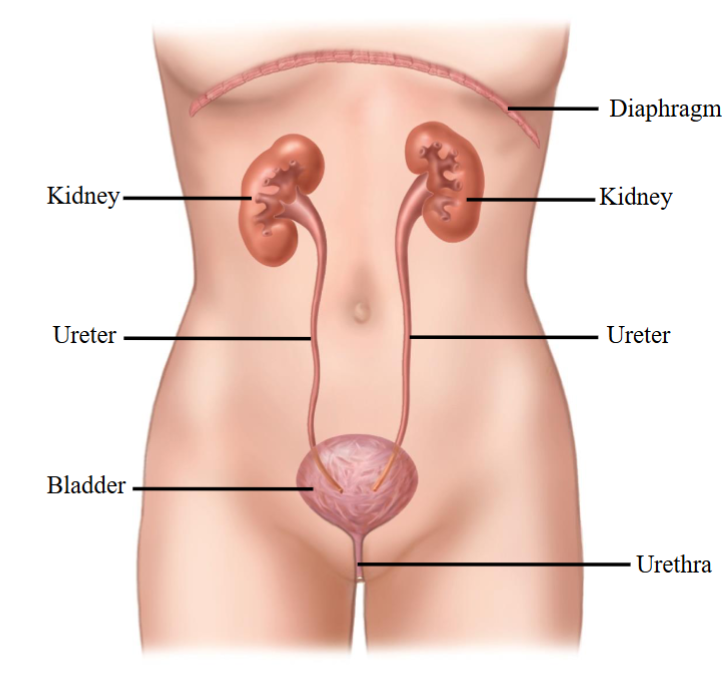
Hilum
Inner concave part of kidneys.
From the area two tubes emerge; these tubes are called ureters.
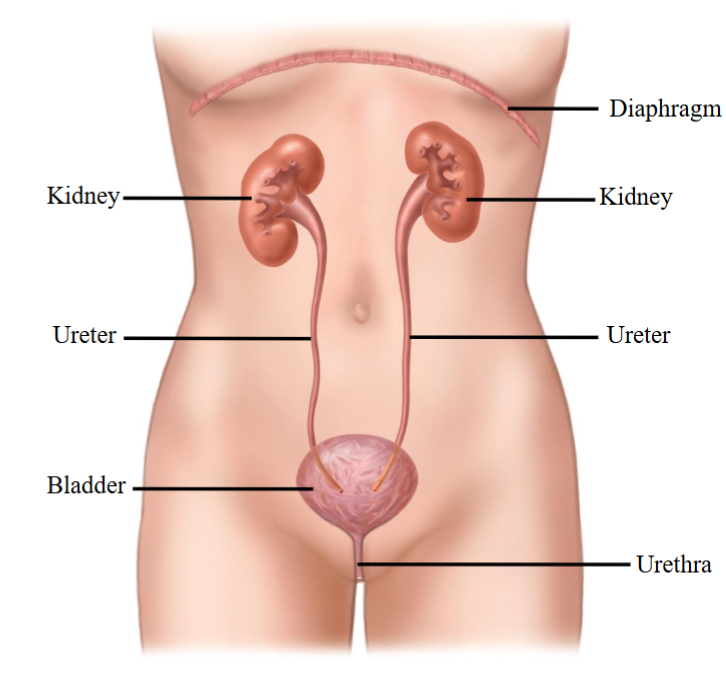
Micturition
The process of releasing the urine outside the body, or urination.
Bladder emptying with the help of autonomic control.
Kidney Anatomy
Covered with a capsule-like structure.
2 regions:
Outer portion: cortex.
Inner portion: medulla.
Nephron
Functional units of the kidney; where the urine is made.
1 million nephrons in your kidneys.
The parts of the nephrons form parts of the cortex and medulla.
Contains: renal corpuscle and renal tubule.
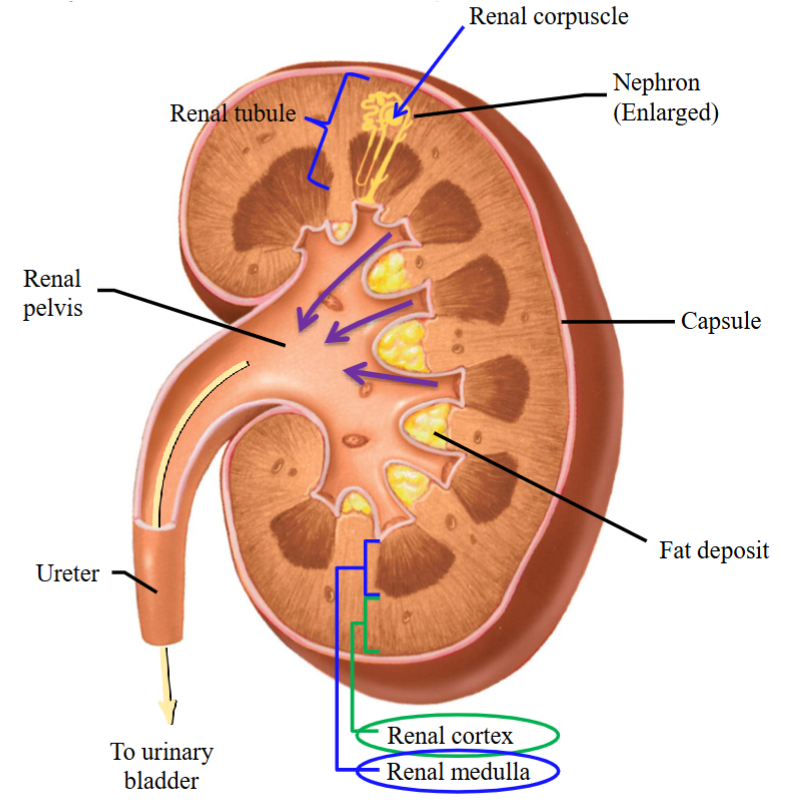
Renal Corpuscle
Bulb-like structure; attached to renal corpuscle is a long tube called the renal tubule.
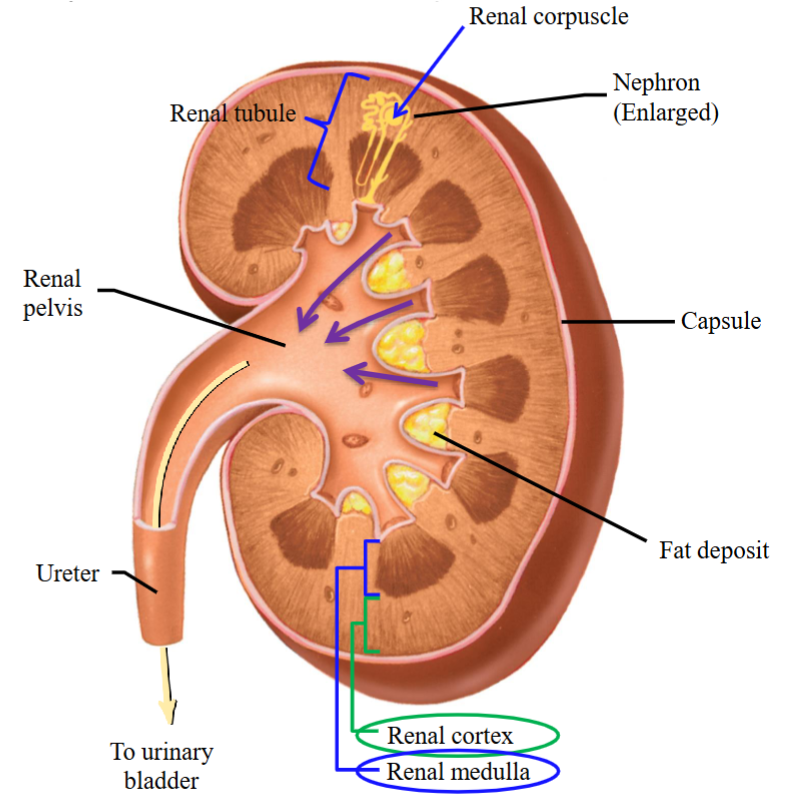
Renal Tubule
Attached to the renal corpuscle; a long tube.
Found mostly in the medullary portion.

Collecting Ducts
Urine starts forming in the nephrons which fuse together and form ducts.
Empty their contents into the renal pelvis.
The formed urine enters into the ureter to be taken away to the bladder.
